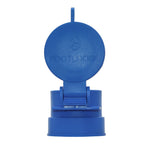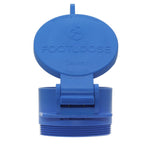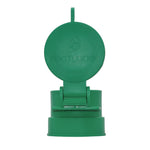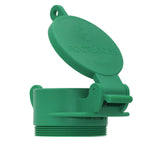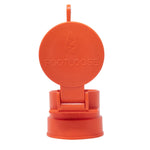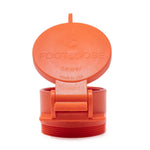You have no items in your shopping cart.
For most of us, manholes exist at the edge of our consciousness. You may only find yourself thinking about them when your car hits one in the road and you experience a bump or when people take refuge underground in an apocalyptic movie.
But there’s really nothing more practical than a manhole. Let’s take a look at the different types of manholes and the purposes they serve.
What does a manhole do?
Manholes are openings that provide access to underground public utilities such as sewers, water, electricity, gas, and telephones. Workers need to access utilities periodically to perform inspections, repairs, and maintenance. The term for these points of access, “man-sized holes,” was shortened to “manhole.” The manhole cover is removable with a manhole cover hook, and authorized workers can access utilities by a ladder that’s usually built just below the surface of the manhole cover.

Aren’t manholes just for sewers?
Originally, manholes were primarily used to provide access to the sewage system beneath the ground. The ancient Roman Empire was famous for its aqueducts that brought water into the city and carried sewage out. In the United States, as technology advanced and homes and buildings began using gas, electricity, and telephones, the approach to laying pipes and placing sewer lines underground was already in place. Other utilities began to join sewers in the underground network of pipes accessed through manholes.
Why place utilities underground?
There are several reasons for placing utilities underground whenever possible:
- Congestion - If you’ve ever seen workers laying power lines in an area and mourned the loss of an unspoiled view, just imagine what we’d be living with if all utilities were above-ground.
- Fumes - One of the original reasons for putting sewer lines underground was to keep sewer fumes away from people, homes, and buildings.
- Safety - Placing utilities underground helps prevent accidental punctures.
- Security - Underground placement decreases the risk of theft and tampering.
So, a manhole is just a hole in the ground with a cover?
At its most basic, yes, a manhole is a hole in the ground with a cover. But manholes and their covers vary in the materials used to make them and the specific purpose they serve. Here are the most common types of manholes used today:
Shallow manhole
A shallow manhole may also be known as an “inspection chamber.” It’s only 2-3 feet deep and usually has a lightweight square or rectangular cover. Shallow manholes are generally built in an area where there isn’t much traffic, such as neighborhoods. You’ll find them wherever branch pipes join the main drainage or when there is a change in the size of the pipe. It’s important to have enough shallow manholes, as they provide access for underground surveys and repairs.
Normal manhole
Normal manholes are 4-5 five feet deep and wide enough for workers to enter through the cover, which is usually square. They’re generally located along the sewage or drainage water line.
Deep manhole
This is the structure you think of when you think of “manholes.” It has a heavy round manhole cover that can be removed with a manhole key and a ladder leading down five feet or more. The cover and the entryway are large enough for workers to enter and work below-ground.

Manhole cover and frame materials
Technology has made it possible to use various materials with different characteristics and price points, to construct manholes and manufacture manhole covers. Here are the primary materials used for manholes:
Manhole cover types
In the old days, manhole covers were heavy cast iron. Today, technology gives much more choice in the materials used for manholes and manhole sewer covers.
- Cast Iron - When you think of lifting a really heavy manhole cover, you’re probably thinking of the material that was used down through history: cast iron. This material is strong and durable.
- Carbon Steel - Like cast iron, carbon steel is metal-based. It is less durable than cast iron but is also much lighter.
- Concrete - Concrete has the advantage of being inexpensive and blending in nicely with the surrounding area. Concrete is initially strong, but over time, it may deteriorate faster than metal materials. To offset deterioration, concrete manhole covers are often reinforced with cast iron at the edges.
- Composite Materials - Plastic manufacturing techniques have made it possible to use fiberglass, plastics, and other composite materials for manhole covers. Composite covers are light, sturdy, and offer options in color, but this material is less durable than the other three and can break down under friction.

Materials for manhole construction
Manhole covers are the readily visible parts of a manhole—there are even historical approaches to the art of decorating manhole covers. But down beneath the surface is the unseen yet vital framework of the manhole itself. Modern manholes are generally constructed of precast concrete, plastic, or fiberglass.
- Precast Concrete - The most traditional material used to construct manholes today is precast concrete. These manhole frames are engineered as segments in a factory located offsite and easily installed and assembled on-site. Concrete continues to be a primary material for the construction of manholes, as it is particularly durable, with a lifespan of around 100 years.
- Plastic Manholes - Plastic manholes are manufactured using polyethylene, making them much more lightweight than concrete. Plastic has a number of advantages: it is manufactured with seamless one-piece construction, which makes it durable, resistant to corrosion, and less likely to have maintenance issues. It is also inexpensive and environmentally friendly, with no adverse impact on the surrounding soil.
- Fiberglass - Fiberglass technology allows manholes to be engineered with all features as one unit: manhole barrel, cover, weirs, flumes, and grinder channels. The technology allows seamless sealing of the units. These manholes are one-tenth the weight of a concrete manhole, making them easy to handle and install, and they are environmentally friendly and highly durable.
So, now you know: manholes are so much more than a heavy lid hiding a bunch of mysteries down in the dark! The next time you’re watching an apocalyptic film and the people take a ladder down into a manhole to escape danger, you’ll be more informed than them about what they can expect to find.



